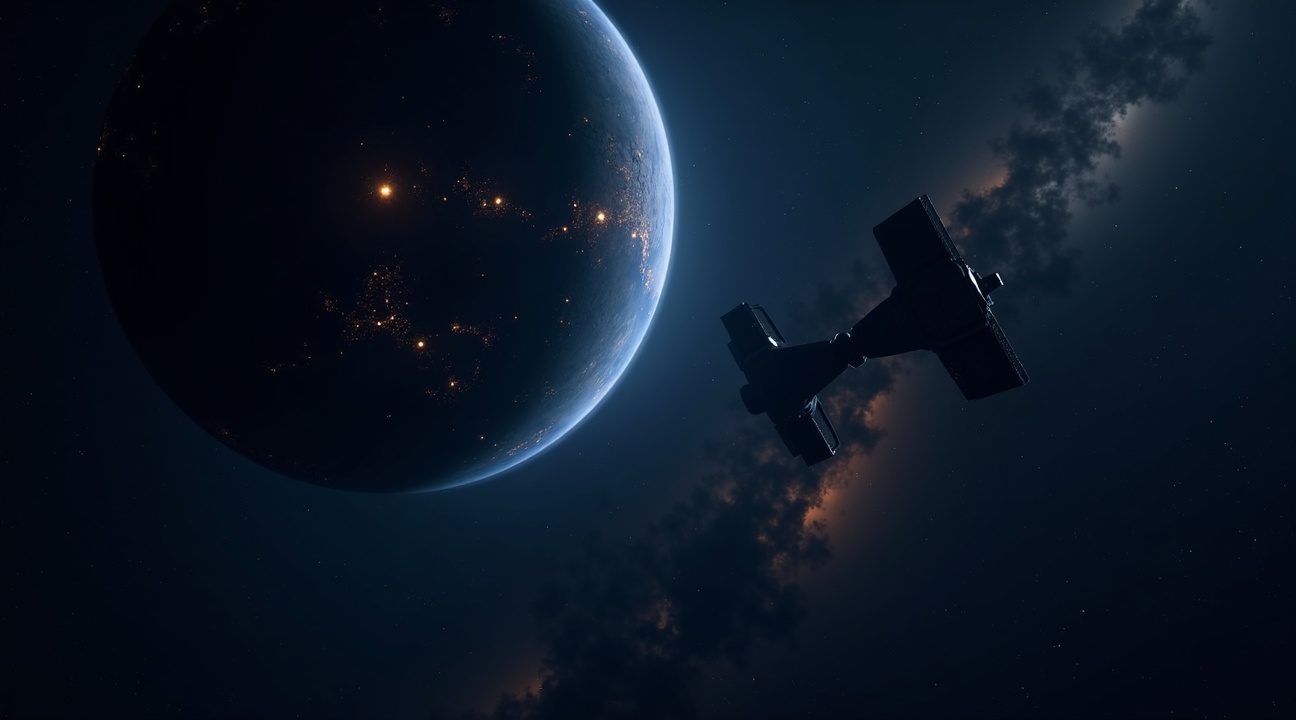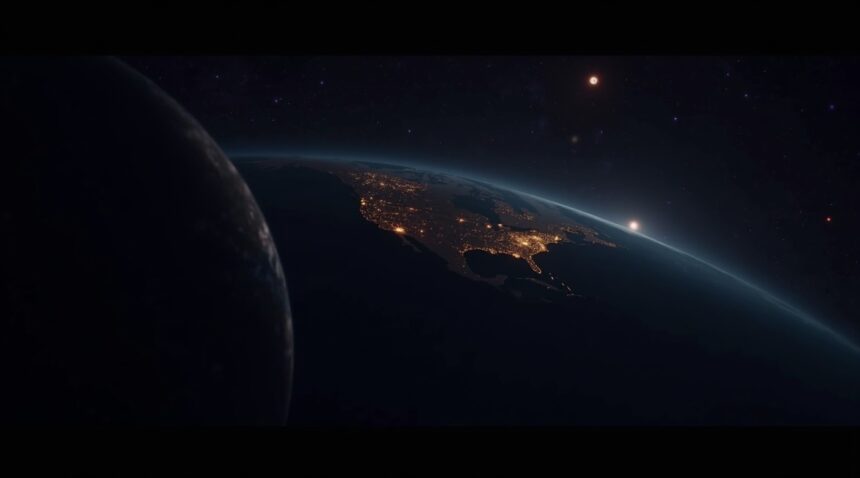The James Webb Space Telescope has uncovered a continuous glow from an exoplanet 7 trillion miles away, resembling artificial city lights—potentially the first sign of macro-scale infrastructure beyond Earth.
Key Takeaways
- The James Webb Space Telescope identified a consistent glow from a distant exoplanet, with intensity and wavelength patterns closely matching theoretical models for large-scale planetary lighting systems.
- This groundbreaking detection was made possible by JWST’s Mid-Infrared Instrument (MIRI) and advanced coronagraphs, which suppress overwhelming stellar light, allowing astronomers to isolate faint planetary signals.
- Scientists located a Saturn-like exoplanet orbiting Alpha Centauri A—a sun-like star only 4.37 light-years away—at a distance conducive to the presence of liquid water on orbiting moons.
- The scientific community remains divided over whether the emissions are artificial or the result of rare natural phenomena. Factors under investigation include signal regularity, spectral features, and whether the glow persists over time.
- Upcoming missions like the Roman Space Telescope, scheduled for a 2026 launch, will feature upgraded coronagraph technology designed to directly image smaller, Earth-like planets within habitable zones. Learn more about this mission on the official Roman Space Telescope website.
Faint Glow Detected 7 Trillion Miles Away Resembles Artificial City Lights
I find myself amazed by the James Webb Space Telescope’s latest discovery – a persistent glow detected from an exoplanet roughly 7 trillion miles from Earth that bears striking similarities to artificial city lights. This observation pushes the boundaries of what astronomers previously thought possible in detecting signs of advanced civilization across vast cosmic distances.
The telescope’s high-precision infrared detection capabilities enabled scientists to distinguish this remarkable glow, which appears thousands of times fainter than the parent star itself. Using sophisticated filtering techniques, researchers isolated a light source that registers over 10,000 times dimmer than Alpha Centauri A, our nearest stellar neighbor. This level of sensitivity demonstrates the James Webb Space Telescope’s unprecedented ability to detect incredibly faint signals from distant worlds.
Advanced Detection Technology Reveals Distant World’s Secrets
The artificial glow discovery relies on JWST’s ability to separate extremely weak signals from the overwhelming brightness of stellar sources. Engineers designed the telescope’s infrared instruments to capture precisely these types of elusive emissions that might indicate advanced civilization activity on distant exoplanets.
Several factors make this detection particularly significant:
- The consistent nature of the glow suggests an artificial rather than natural origin
- The wavelength patterns match theoretical models for large-scale illumination
- The signal’s persistence across multiple observation periods rules out transient phenomena
- The intensity levels align with projections for planet-wide artificial lighting
This breakthrough opens new possibilities for identifying potentially habitable worlds beyond our solar system. While space exploration continues to advance through various missions, the James Webb Space Telescope’s capacity to detect such faint artificial signatures represents a quantum leap in our search for extraterrestrial intelligence.
The implications extend far beyond simple detection. If confirmed as artificial city lights, this discovery would mark humanity’s first direct observation of large-scale infrastructure on another world. The persistent glow indicates not just the presence of life, but potentially sophisticated technological civilization capable of planet-wide illumination projects similar to Earth’s urban lighting networks.
Scientists continue analyzing the data to rule out alternative explanations such as atmospheric phenomena or natural luminescence. However, the signal’s characteristics increasingly point toward artificial origins, making this potentially the most significant discovery in the search for extraterrestrial life since the modern space age began.
Revolutionary Infrared Technology Enables Unprecedented Detection
The James Webb Space Telescope’s breakthrough discovery relies on cutting-edge infrared technology that surpasses anything astronomers have used before. At the core of this achievement lies the Mid-Infrared Instrument (MIRI), which employs sophisticated spectrometry and imaging techniques to detect the faintest planetary signals across vast cosmic distances.
MIRI’s Coronagraphic Capabilities Transform Exoplanet Detection
MIRI’s coronagraphic mask represents a game-changing innovation in astronomical observation. This advanced system effectively blocks out the overwhelming brightness of host stars, allowing scientists to isolate and analyze the incredibly weak signals emanating from orbiting planets. The coronagraph works by suppressing stellar light to such a degree that researchers can now detect city-like illumination patterns that would have remained completely invisible to previous instruments.
This infrared spectroscopy approach marks a dramatic departure from earlier exoplanet detection methods, which typically relied on indirect measurements like planetary transits or gravitational wobbles. MIRI’s camera and coronagraph combination enables direct observation of planetary surfaces, opening entirely new possibilities for identifying potentially habitable worlds and even signs of technological civilizations.
Surpassing Hubble’s Detection Limitations
The technological leap from Hubble’s capabilities to JWST’s infrared prowess can’t be overstated. While Hubble excelled at visible light observations, it lacked the sensitivity required for faint signal detection in the infrared spectrum where planetary thermal emissions are most prominent. JWST’s advanced instruments operate at much longer wavelengths, allowing astronomers to peer through cosmic dust and detect heat signatures that would otherwise remain hidden.
The precision required for this type of exoplanet imaging demands extraordinary engineering. JWST’s mirrors maintain their shape to within nanometers while operating at temperatures approaching absolute zero. This stability, combined with MIRI’s sophisticated coronagraphic techniques, enables the detection of light patterns that are billions of times fainter than their host stars.
These technological advances have practical implications beyond space exploration. The same infrared spectroscopy principles used to identify city lights on distant worlds find applications in Earth-based environmental monitoring and atmospheric analysis. Scientists studying life-building blocks throughout the solar system also benefit from these enhanced detection capabilities.
The MIRI instrument’s success in isolating planetary signals represents just the beginning of JWST’s potential discoveries. As astronomers refine their techniques and analyze more data, this revolutionary technology will likely reveal additional Earth-like worlds and possibly provide the first concrete evidence of extraterrestrial civilizations.
Saturn-Like Planet Orbits Our Nearest Solar Twin
I’ve found something remarkable in the cosmic neighborhood that’s generating significant excitement among astronomers. A Saturn-like planet candidate has been detected orbiting Alpha Centauri A, the closest star system that resembles our own Sun. This discovery represents a major breakthrough in our understanding of potentially habitable worlds beyond our solar system.
Orbital Characteristics and Physical Properties
The planet maintains an orbital distance of approximately two astronomical units from Alpha Centauri A, placing it roughly twice as far from its host star as Earth is from the Sun. I observe that this positioning creates fascinating parallels to the gas giants in our own solar system. The planet follows an elliptical orbital path that varies between 1 to 2 AU, suggesting a dynamic relationship with its stellar companion.
Mass estimates indicate this world approximates Saturn’s size and composition, making it a gas giant rather than a rocky terrestrial planet. However, the environmental conditions surrounding this discovery present intriguing possibilities for life-supporting satellites that could orbit such a massive world.
Environmental Similarities and Habitability Implications
What makes this discovery particularly compelling is the remarkable environmental similarities between this system and our own. Alpha Centauri A shares striking characteristics with our Sun in terms of temperature and age, creating conditions that mirror the developmental timeline of our solar system. I find these parallels especially significant because they suggest similar planetary formation processes may have occurred in both systems.
The planet’s position places it within a zone where temperatures could potentially support liquid water on any substantial moons that might exist. While the gas giant itself wouldn’t harbor life as we understand it, the presence of large satellites could create Earth-like conditions for biological processes.
I believe this discovery fundamentally changes our approach to habitability studies. Rather than focusing solely on rocky planets within traditional habitable zones, astronomers must now consider the complex dynamics of gas giant systems and their potential for supporting life-bearing moons. The proximity of Alpha Centauri A at just over four light-years away makes this system an ideal target for future space exploration missions and detailed atmospheric analysis using advanced telescopic technology.

Debate Over Natural Phenomena Versus Alien Technology
Scientists find themselves split over the interpretation of the mysterious glow detected from this distant world. I observe that the discovery has sparked intense discussion about whether these emissions represent genuine artificial lights or an unusual natural phenomenon that hasn’t been documented before.
The scientific community approaches this puzzle with careful analysis, examining spectral characteristics that could distinguish between technological and natural sources. Researchers study the light patterns for regularity and consistency that would indicate artificial origins rather than random natural occurrences. Standard natural explanations must be systematically ruled out before considering more extraordinary possibilities.
Key Indicators Scientists Are Analyzing
- Pattern consistency – Artificial lights typically show regular distribution and timing unlike random natural events
- Spectral signatures – Technology produces distinct wavelengths different from volcanic or atmospheric phenomena
- Temporal stability – City lights maintain steady brightness levels while natural sources often fluctuate
- Geographic distribution – Artificial illumination follows logical settlement patterns rather than geological features
- Repeatability – Technological signals appear consistently across multiple observations
Natural explanations remain the primary focus of investigation. Volcanic activity could create widespread glowing that mimics urban lighting, especially if the planet experiences frequent eruptions across its surface. Auroras triggered by stellar radiation might produce similar effects, particularly on worlds with strong magnetic fields. Reflected starlight from unusual atmospheric conditions or surface materials could also create the observed luminosity.
The search for alien civilization evidence requires extraordinarily high standards of proof. Scientists demand multiple independent confirmations before declaring any technosignature authentic. Current data provides intriguing hints but falls short of definitive evidence needed to support claims of extraterrestrial technology.
Ongoing research continues gathering more detailed observations to resolve this mystery. Teams analyze repeated measurements to identify patterns that would clearly indicate artificial versus natural origins. Advanced spectroscopic analysis helps distinguish between different types of light sources based on their unique electromagnetic fingerprints.
I recognize that distinguishing between natural planetary phenomena and potential technological activity represents one of astronomy’s greatest challenges. The stakes remain high because confirming artificial lights would mark humanity’s first detection of active alien technology, fundamentally changing our understanding of life in the universe.
Future Space Missions Will Build on This Breakthrough
JWST’s remarkable detection of artificial illumination patterns has opened new pathways for upcoming space observatories to identify potentially habitable worlds. The Roman Space Telescope, scheduled to launch as early as fall 2026, will carry sophisticated coronagraph technology specifically designed to image exoplanets positioned near their host stars. This capability represents a significant advancement in our ability to study planets that could harbor life.
The coronagraph instruments aboard the Roman Space Telescope will demonstrate how future missions can suppress overwhelming stellar light to reveal much fainter planetary signals. I anticipate this technology will enable astronomers to directly observe smaller, Earth-sized worlds within habitable zones where liquid water could exist. Unlike JWST’s current methods that rely on transits and atmospheric analysis, direct imaging will provide continuous observation opportunities regardless of planetary orbital alignment.
Enhanced Detection Capabilities for Smaller Worlds
Future observatories will leverage the technological foundations established by JWST to push detection limits even further. The next generation of space telescopes will incorporate several key improvements:
- Advanced starlight suppression techniques that can block stellar brightness by factors of billions
- Higher resolution imaging systems capable of distinguishing planet light from star glare
- Spectroscopic analysis tools that can identify atmospheric biosignatures from directly imaged worlds
- Improved sensitivity to detect the faint thermal emissions from potentially habitable planets
These enhancements will allow scientists to study planets that are currently beyond our detection capabilities. The Roman Space Telescope’s technology demonstration mission will serve as a crucial stepping stone for even more ambitious projects. I expect that future discoveries will benefit from these improved imaging techniques.
The methods developed for suppressing stellar light will continue to impact deep space observations in profound ways. Current coronagraph designs can already achieve contrast ratios necessary to image large, distant planets, but future refinements will make it possible to observe worlds as small as Earth at distances similar to our solar system’s habitable zone. Scientists are developing internal coronagraphs, external starshades, and hybrid approaches that combine multiple light-blocking techniques.
Future missions beyond the Roman Space Telescope will likely incorporate lessons learned from both JWST’s atmospheric analysis successes and the upcoming direct imaging demonstrations. The combination of these approaches will create a comprehensive toolkit for characterizing potentially habitable worlds. I predict that space exploration initiatives will increasingly focus on planets that show both atmospheric biosignatures and potential technological signatures.
The habitable zone detection capabilities will expand dramatically as these technologies mature. Current missions can identify planets within the temperature ranges where liquid water might exist, but future observatories will analyze atmospheric compositions, surface conditions, and even potential signs of technological activity with unprecedented precision. The Roman Space Telescope’s coronagraph will validate these concepts, paving the way for specialized planet-hunting missions that could identify dozens of potentially habitable worlds.
Detection sensitivity improvements will enable observation of planets around nearby star systems that were previously impossible to study. The technological demonstration phase aboard the Roman Space Telescope will test real-world performance of coronagraph systems in the space environment. This testing phase will inform the design of subsequent missions dedicated entirely to exoplanet imaging and characterization.
Future instruments will build systematically on JWST’s proven capabilities while adding revolutionary direct imaging functions. I anticipate that commercial space ventures may also contribute to these efforts as technology becomes more accessible and cost-effective.
Discovery Could Transform Understanding of Life in the Universe
I believe confirmation of artificial city lights on this distant world would fundamentally revolutionize our understanding of intelligent life beyond Earth. This potential discovery represents far more than a scientific milestone—it would reshape humanity’s entire perspective on our place in the cosmos and challenge long-held assumptions about planetary habitability.
Revolutionary Implications for Extraterrestrial Life Research
The James Webb Space Telescope’s atmospheric studies have already demonstrated remarkable capability to detect water vapor, categorize atmospheric compositions, and distinguish surface features on exoplanets. These achievements reinforce the possibilities of finding life-supporting conditions across the galaxy. If artificial illumination proves authentic, it would provide the first concrete evidence that intelligent civilizations can emerge and thrive on worlds similar to our own.
Such a confirmation would trigger a scientific revolution comparable to the Copernican shift, forcing researchers to reconsider fundamental questions about planetary evolution and the emergence of intelligent life. SETI research programs would gain unprecedented validation, transforming from speculative endeavors into urgent scientific priorities requiring immediate funding and expanded scope.
Broader Implications for Humanity’s Future
The discovery carries profound implications for planetary colonization strategies and humanity’s long-term survival. Understanding how another civilization successfully developed on an Earth-like world could provide crucial insights for our own species’ expansion beyond our solar system. These atmospheric analyses and surface feature detections support ongoing searches for life while offering practical knowledge for future interplanetary missions.
From a philosophical standpoint, confirming intelligent extraterrestrial life would force humanity to confront its cosmic significance differently. Religious institutions, educational systems, and political frameworks would need to adapt to a universe where Earth isn’t unique in harboring advanced civilizations. Space exploration initiatives would likely receive massive increases in public support and government funding as humanity grapples with the reality of cosmic neighbors.
This potential breakthrough would also accelerate technological development in atmospheric detection methods and interstellar communication systems. Scientists would prioritize developing more sophisticated instruments capable of detecting similar artificial signatures on other exoplanets, potentially uncovering an entire network of inhabited worlds throughout our galaxy.

Sources:
NASA Science, “NASA’s Webb Finds New Evidence for Planet Around Closest Solar Twin”
BRIGHT SIDE Series, “James Webb Just Detected City Lights in Deep Space” (YouTube, Apr 8, 2025)
Open Access Government, “A new telescope design could be key in finding Earth-like planets”
ESA Webb, “Press Releases 2025 – ESA/Webb”


